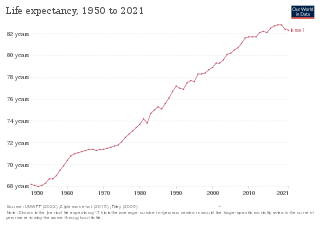
Smoking bans, or smoke-free laws, are public policies, including criminal laws and occupational safety and health regulations, that prohibit tobacco smoking in certain spaces. The spaces most commonly affected by smoking bans are indoor workplaces and buildings open to the public such as restaurants, bars, office buildings, schools, retail stores, hospitals, libraries, transport facilities, and government buildings, in addition to public transport vehicles such as aircraft, buses, watercraft, and trains. However, laws may also prohibit smoking in outdoor areas such as parks, beaches, pedestrian plazas, college and hospital campuses, and within a certain distance from the entrance to a building, and in some cases, private vehicles and multi-unit residences.

Health in Israel is generally considered good.

The use of tobacco for smoking in New Zealand has been subjected to government regulation for a number of decades. On 10 December 2004, New Zealand became the third country in the world to make all indoor workplaces including bars and restaurants smoke-free. The smoking rate in New Zealand was about 8% as of 2023 when the new government planned to eliminate the nation's smoking ban to fund tax cuts.

Tobacco politics refers to the politics surrounding the use and distribution of tobacco.

Tobacco control is a field of international public health science, policy and practice dedicated to addressing tobacco use and thereby reducing the morbidity and mortality it causes. Since most cigarettes and cigars and hookahs contain/use tobacco, tobacco control also concerns these. E-cigarettes do not contain tobacco itself, but (often) do contain nicotine. Tobacco control is a priority area for the World Health Organization (WHO), through the Framework Convention on Tobacco Control. References to a tobacco control movement may have either positive or negative connotations, depending upon the commentator.

The Family Smoking Prevention and Tobacco Control Act, is a federal statute in the United States that was signed into law by President Barack Obama on June 22, 2009. The Act gives the Food and Drug Administration the power to regulate the tobacco industry. A signature element of the law imposes new warnings and labels on tobacco packaging and their advertisements, with the goal of discouraging minors and young adults from smoking. The Act also bans flavored cigarettes, places limits on the advertising of tobacco products to minors and requires tobacco companies to seek FDA approval for new tobacco products.
Smoking in China is prevalent, as the People's Republic of China is the world's largest consumer and producer of tobacco. As of 2022, there are around 300 million Chinese smokers, and 2.4 trillion cigarettes are sold there every year, 46% of the world total.

Smokingamong youth and adolescents is an issue that affects countries worldwide. While the extent to which smoking is viewed as a negative health behavior may vary across different nations, it remains an issue regardless of how it is perceived by different societies. The United States has taken numerous measures, ranging from changes in national policy surrounding youth cigarette access to changes in media campaigns, in attempts to eliminate the use of tobacco products among teenagers. Approximately 90% of smokers begin smoking prior to the age of 18.
The Massachusetts Tobacco Cessation and Prevention Program (MTCP) is an anti-tobacco program run by the Massachusetts Department of Public Health with the goal of decreasing tobacco prevalence in the state of Massachusetts. MTCP has four main components: preventing youth smoking, protecting against second hand smoke, assisting current smokers with quitting, and eliminating tobacco related disparities. Since the program began in, adult smoking rates have declined from 22.6% in 1993 to 16.1% in 2008, allowing Massachusetts the 4th lowest smoking rates in the country.

The use of tobacco products in Egypt is widespread. It is estimated that approximately twenty percent of the population uses tobacco products daily. Cigarettes are the most common form of tobacco consumption in Egypt, with an estimated twenty billion cigarettes smoked annually in the country. After cigarettes, shisha water-pipes are the most common form of tobacco consumption.

SmokinginCanada is banned in indoor public spaces, public transit facilities and workplaces, by all territories and provinces, and by the federal government. As of 2010, legislation banning smoking within each of these jurisdictions is mostly consistent, despite the separate development of legislation by each jurisdiction. Notable variations between the jurisdictions include: whether, and in what circumstances ventilated smoking rooms are permitted; whether, and up to what distance away from a building is smoking banned outside of a building; and, whether smoking is banned in private vehicles occupied by children.
Smoking in Ecuador is more common among men and younger people. According to a study in 2004, 49.4% of men and 13.1% of women smoke. More than half of Ecuadorian smokers desire to quit. The Government of Ecuador plans to reduce second-hand smoke in public spaces by 2012. The tobacco industry in Ecuador includes the major players of Tabacalera Andina SA and British American Tobacco Ltd. Smoking is expected to decrease as the government enacts laws and the public becomes more aware of the dangers of smoking. Smoking is common in bars and dance clubs, but non-smoking signs in restaurants in Quito are generally respected.
Smoking in South Korea has decreased overall for both men and women in the past decades. However, a high prevalence of tobacco use is still observed, especially with the rise of novel tobacco products such as e-cigarettes and heat-not-burn tobacco products. There are socioeconomic inequalities in smoking prevalence according to gender, income, education, and occupational class. Advocates call for measures to reduce the smoking rates and address smoking inequalities using a combination of monitoring and tobacco control policies. These measures include significant price hikes, mandatory warning photos on cigarette packs, advertising bans, financial incentives, medical help for quitting, and complete smoking bans in public places.

Smoking in Greece was at the highest rate of tobacco consumption in the European Union in 2010. In 2014, Greece had the highest rate of smoking in the European Union. According to a survey published by the European Commission Day for World No Tobacco Day in 2017, 37% of Greeks are smokers and only 44% of Greeks have never smoked a cigarette, the smallest percentage in the EU. After Greece, France and Bulgaria have the next largest number of smokers with 36%. At 7%, Sweden had the lowest rate.

Tobacco policy in Armenia is the attempt by the Armenian authorities to regulate smoking in Armenia. Tobacco laws and regulations are controlled by the Ministry of Health of Armenia. Armenian men tend to be the most common tobacco users, as 42.5% of men over the age of 15 smoke.

As nicotine is highly addictive, marketing nicotine-containing products is regulated in most jurisdictions. Regulations include bans and regulation of certain types of advertising, and requirements for counter-advertising of facts generally not included in ads. Regulation is circumvented using less-regulated media, such as Facebook, less-regulated nicotine delivery products, such as e-cigarettes, and less-regulated ad types, such as industry ads which claim to discourage nicotine addiction but seem, according to independent studies, to promote teen nicotine use.
Life expectancy in Bahrain at birth in 2013 was 76 for men and 78 for women. Compared to many countries in the region, the prevalence of AIDS and HIV is relatively low. Malaria and tuberculosis (TB) do not constitute major problems in Bahrain as neither disease is indigenous to the country. As a result, cases of malaria and TB have declined in recent decades with cases of contractions amongst Bahraini nationals becoming rare. The Ministry of Health sponsors regular vaccination campaigns against TB and other diseases such as hepatitis B.
Smoking in Latvia is common, with a rate higher than the OECD average, and Latvian men are among the heaviest smokers in the European Union. One in four Latvians smoke, as compared to one in five in the rest of the European Union. While the overall smoking rate in Latvia has decreased in recent years, it is considered a significant factor in the country's significant health challenges, particularly with regard to preventable diseases such as heart disease, diabetes, and cancer.
Smoking in Australia is restricted in enclosed public places, workplaces, in areas of public transport and near underage events, except new laws in New South Wales that ban smoking within ten metres of children's play spaces.












